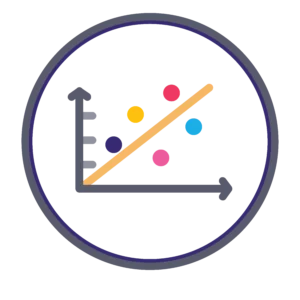Data & Graphs
Table of Contents
Welcome back to our RBT Competency Assessment blog post series! In this post we will be covering task 3 from the measurement section of the assessment: data and graphs. In this series, we are diving into each task on the RBT Competency Assessment to help new Behavior Technicians (BTs) prepare for their initial competency assessments and provide a valuable refresher for Registered Behavior Technicians (RBTs) renewing their certification.
Data collection and graphing are critical components in the field of Applied Behavior Analysis (ABA). Accurate data collection is essential for developing effective intervention and treatment plans, tracking progress, and making data-driven decisions. Graphs provide a visual representation of this data, making it easier to analyze and interpret behavior patterns over time.
In this blog post, we will explore the importance of taking data and using graphs in ABA. We’ll discuss how these tools assist in developing and adjusting treatment plans and provide practical examples using two of the most popular data software programs in the ABA world: CentralReach and Catalyst. By understanding and mastering these techniques, RBTs can enhance their ability to monitor and analyze behavior, ensuring that clients receive the most effective and personalized care.
Let’s begin by defining what data and graphs are in the context of ABA and discussing their significance in the treatment process.
What are Data and Graphs in ABA?
Data Collection in ABA:
Data collection in Applied Behavior Analysis (ABA) involves systematically recording specific behaviors and responses during therapy sessions. This data provides a factual basis for analyzing a client’s progress and the effectiveness of the intervention strategies used. Data can be collected in various forms, such as frequency (how often a behavior occurs), duration (how long a behavior lasts), latency (time taken for a behavior to start after a prompt), and more. This information is crucial for making informed decisions about treatment plans and adjusting them as needed to better meet the client’s needs.
Graphs in ABA:
Graphs are visual representations of the collected data. They help behavior analysts and RBTs to easily interpret and analyze behavior patterns over time. Common types of graphs used in ABA include line graphs, bar graphs, and scatter plots. These graphs can display trends, compare behaviors before and after interventions, and highlight areas that may require more attention. By visualizing data, graphs make it easier to communicate progress to clients, their families, and other stakeholders involved in the treatment process.

Why are Data and Graphs Important?
Benefits of Accurate Data Collection and Graphing:
- Informed Decision-Making: Accurate data collection and graphing provide a solid foundation for making data-driven decisions about treatment plans. This ensures that interventions are based on objective information rather than subjective observations.
- Tracking Progress: Regularly collecting data and graphing it allows behavior analysts to track a client’s progress over time. This helps in identifying trends, assessing the effectiveness of interventions, and making necessary adjustments to improve outcomes.
- Identifying Patterns: Graphs can reveal patterns in behavior that may not be immediately apparent from raw data. For example, a line graph might show that a behavior occurs more frequently at certain times of the day or in specific settings.
- Communication: Visual data representations are more accessible and easier to understand for clients, their families, and other stakeholders. Graphs can effectively communicate progress and areas of concern, fostering collaboration and support.
- Accountability: Data and graphs provide a clear record of interventions and their outcomes. This accountability is essential for maintaining high standards of practice and demonstrating the effectiveness of ABA therapy.
By utilizing data and graphs effectively, RBTs and behavior analysts can ensure that their interventions are targeted, effective, and responsive to the needs of their clients. This approach not only enhances the quality of care but also empowers clients and their families with clear and understandable information about their progress.
Using Data Software Programs: CentralReach and Catalyst
CentralReach
CentralReach is a comprehensive platform designed for data collection and management in ABA. It offers a variety of tools to streamline the data collection process, making it easier for RBTs to monitor and analyze client behavior.
Step-by-Step Guide for Entering Data and Generating Graphs:
Log In:
- Access CentralReach via the web or mobile app using your credentials.
Select Client:
- From your dashboard, select the client you are working with.
Choose Data Type:
- Select the type of data you need to collect (e.g., frequency, duration, ABC data).
Record Data:
- Use the interface to record data in real-time. For instance, for frequency, click the button each time the behavior occurs.
Save Data:
- Ensure all data entries are saved, especially if you are using the mobile app offline.
Sync Data:
- If you collected data offline, sync once you have internet access to update the database.
Generate Graphs:
- Navigate to the reporting section and select the data you want to graph. Customize the graph settings to visualize trends and patterns effectively.
Example: Imagine you are tracking a student’s instances of hand-raising in class. Using CentralReach, you can log each occurrence, save the data, and later generate a line graph to visualize how the behavior changes over time. This helps you identify if your interventions are effective.
Video Tutorial
For a detailed visual guide, watch this video on CentralReach by the youtube creator Autism Learning Partners.
Catalyst
Catalyst is another powerful tool for ABA data collection and management. It offers a user-friendly interface and a range of features to support data-driven decision-making.
Step-by-Step Guide for Entering Data and Generating Graphs:
Log In:
- Access Catalyst via the web or mobile app using your credentials.
Select Client:
- Choose the client you are working with from your list.
Choose Program:
- Select the specific behavior program or treatment plan you are implementing.
Enter Data:
- Record data by selecting the appropriate behavior and entering occurrences, durations, or other relevant metrics.
Save and Sync:
- Save the data entries and sync with the server to ensure all information is up-to-date.
Generate Graphs:
- Use the reporting tools to create graphs that display the collected data. Customize the graphs to highlight key trends and progress.
Example: If you are tracking the duration of a student’s on-task behavior during homework, you can log the start and end times for each session. Catalyst will then allow you to create a graph showing the duration over multiple sessions, helping you assess the effectiveness of your strategies.
Video Tutorial
For a detailed visual guide, watch this video on Catalyst by the youtube creator Hannah West
By leveraging these tools, RBTs can enhance their data collection processes, making it easier to track progress and adjust treatment plans as needed. The use of CentralReach and Catalyst not only simplifies data management but also ensures that interventions are based on accurate and up-to-date information.
FAQ on Data and Graphs in ABA
- Q: What graph is used in ABA?
- A: In ABA, various types of graphs are used to represent data visually. The most common types are line graphs, bar graphs, and scatter plots. Line graphs are particularly popular for displaying changes in behavior over time, as they can clearly show trends and progress. Bar graphs are often used to compare different sets of data, while scatter plots can illustrate the relationship between two variables.
- Q: What is data in ABA?
- A: Data in ABA refers to the systematic collection of information about a client’s behavior. This includes recording specific behaviors, responses to interventions, and other relevant information during therapy sessions. Data can be collected in various forms, such as frequency (how often a behavior occurs), duration (how long a behavior lasts), and latency (time taken for a behavior to start after a prompt). This data is essential for analyzing a client’s progress and the effectiveness of the treatment plan.
- Q: What are data and graphs?
- A: Data in ABA involves recording measurable information about behaviors and responses during therapy sessions. Graphs are visual tools used to represent this data, making it easier to analyze and interpret behavior patterns over time. Graphs help behavior analysts and RBTs to see trends, compare different sets of data, and communicate progress to clients, their families, and other stakeholders.
- Q: What types of graphs are preferred by ABA?
- A: In ABA, the preferred types of graphs include:
- Line Graphs: Ideal for showing changes in behavior over time and identifying trends.
- Bar Graphs: Useful for comparing different sets of data or behaviors.
- Scatter Plots: Helpful for illustrating the relationship between two variables. These graphs are chosen based on their ability to clearly convey the relevant information and facilitate data-driven decision-making in treatment planning.
- A: In ABA, the preferred types of graphs include:
Final Thoughts
Data collection and graphing are fundamental components in Applied Behavior Analysis (ABA). They provide the essential framework for making informed, data-driven decisions that enhance the effectiveness of treatment plans. By accurately recording and visualizing data, behavior analysts and RBTs can track progress, identify patterns, and adjust interventions to better meet the needs of their clients.
The use of advanced data software programs like CentralReach and Catalyst further simplifies this process, offering powerful tools for efficient data management and analysis. These platforms provide a user-friendly interface for recording data, generating graphs, and syncing information, ensuring that RBTs have access to accurate and up-to-date data at all times.
Mastering the techniques of data collection and graphing not only improves the quality of care provided but also empowers clients and their families with clear and understandable information about their progress. By leveraging these tools and methods, RBTs can make a significant positive impact on the outcomes of ABA therapy.
Explore More Resources
If you found this guide on data and graphs in ABA helpful, be sure to explore more resources on our website. We offer a wealth of information, including detailed articles, study guides, and practical tips to help you succeed as a Registered Behavior Technician (RBT).
Are you preparing for the RBT competency assessment? Check out our comprehensive study materials and mock exams designed to help you ace the test and become a confident, competent RBT.
Don’t forget to visit our ABA Schwag Shop for unique and fun merchandise! Show your pride in the field with our selection of ABA or RBT-themed shirts, mugs, and more.
For more information on becoming a Registered Behavior Technician and for the latest research and resources in Applied Behavior Analysis, visit the Behavior Analyst Certification Board (BACB) website.
Share this blog with your peers and colleagues to spread the knowledge and support the ABA community!



